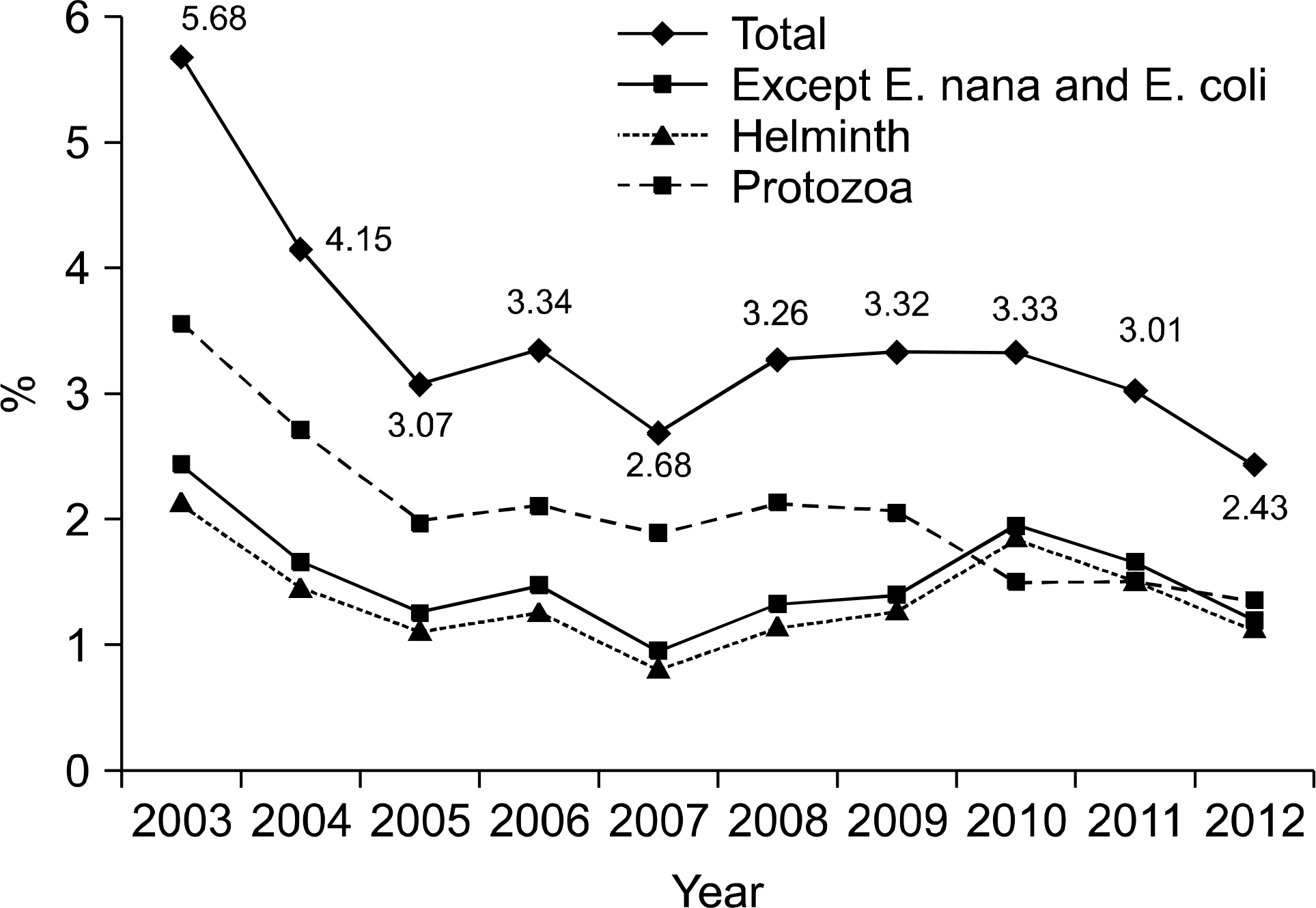Ann Clin Microbiol.
2013 Sep;16(3):134-139. 10.5145/ACM.2013.16.3.134.
A Survey of Intestinal Parasite Infection during a 10-Year Period (2003-2012)
- Affiliations
-
- 1Department of Laboratory Medicine and Genetics, Samsung Medical Center, Sungkyunkwan University School of Medicine, Seoul, Korea. micro.lee@samsung.com
- KMID: 1494330
- DOI: http://doi.org/10.5145/ACM.2013.16.3.134
Abstract
- BACKGROUND
Due to a reduction in the number of parasite infections, attention paid to the importance of intestinal parasites has decreased. However, intestinal parasite infections remain ubiquitous and have reappeared as a growing problem in recent decades due to changing lifestyles such as increased overseas travel. In this study, we evaluated trends in intestinal parasite infection using stool examination in a single institute.
METHODS
From January 2003 to December 2012, we reviewed all stool examination results performed at Samsung Medical Center. Fecal examinations were performed by formalin-ether sedimentation.
RESULTS
A total 429,866 stool examinations were performed resulting in 14,672 cases with positive findings of helminth eggs or protozoan cysts, of which the positive rate was 3.41% on average. The annual positive rate decreased from 5.68% in 2003 to 2.43% in 2012. The positive rate of intestinal parasites, excepting Endolimax nana and Entamoeba coli, was 1.52% on average. Positive rates decreased from 2.13% to 1.10% for helminth egg detections and from 2.55% to 1.30% for protozoan cyst detections during the same time period. Among nematodes, Trichuris tricuria was the most common and had an increasing positive rate after 2010. Clonorchis sinensis was the most prevalent trematode parasite, with an annual average of 528 cases.
CONCLUSION
Infection rates of intestinal parasites have decreased over the last 10 years. However, Trichuris tricuria has reappeared and has become a major contributor to parasite infections. Further education and control efforts are needed for greater prevention and eventual eradication of parasitic infections.
Figure
Cited by 1 articles
-
Status of common parasitic diseases in Korea in 2019
Sun Huh
J Korean Med Assoc. 2019;62(8):437-456. doi: 10.5124/jkma.2019.62.8.437.
Reference
-
1.Seo BS., Rim HJ., Loh IK., Lee SH., Cho SY., Park SC, et al. Study on the status of helminthic infections in Koreans. Kisaengchunghak Chapchi. 1969. 7:53–70.
Article2.Kim TS., Cho SH., Huh S., Kong Y., Sohn WM., Hwang SS, et al. Working groups in national institute of health; Korea association of health promotion. A nationwide survey on the prevalence of intestinal parasitic infections in the Republic of Korea, 2004. Korean J Parasitol. 2009. 47:37–47.3.Kim HS., Lee JH., Choi YH., Kim JH., Son HJ., Rhee PL, et al. Examination for helminth eggs and protozoan cysts in fecal samples from healthy Korean adults, 2000-2006. Korean J Med. 2009. 77:741–9.4.Ahn MH. Imported parasitic diseases in Korea. Infect Chemother. 2010. 42:271–9.
Article5.Ahn MH. Traveling and imported parasitic diseases. J Korean Med Assoc. 2007. 50:993–1004.
Article6.Kim YS. Information about parasitic infections for the international travelers. J Korean Med Assoc. 2004. 47:508–11.
Article7.Shin SS. Parasitic zoonosis transmitted by pet animals. J Korean Med Assoc. 2004. 47:527–34.
Article8.Chai JY. Emerging parasitic diseases in Korea. J Korean Med Assoc. 2007. 50:946–58.
Article9.Ahn MH. Changing patterns of human parasitic infection in Korea. Hanyang Med Rev. 2010. 30:149–55.
Article10.Chai JY. Foodborne parasitic diseases. J Korean Med Assoc. 2004. 47:496–507.
Article11.Chai JY., Park JH., Guk SM., Kim HJ., Kim WH., Kim JL, et al. Status of intestinal parasite infections among 4,137 residents from provinces nationwide and metropolitan areas in the republic of Korea (2004). Infect Chemother. 2006. 38:198–203.12.Lee SH. Transition of parasitic diseases in Korea. J Korean Med Assoc. 2007. 50:937–45.
Article13.Hong ST., Chai JY., Choi MH., Huh S., Rim HJ., Lee SH. A successful experience of soil-transmitted helminth control in the republic of Korea. Korean J Parasitol. 2006. 44:177–85.
Article14.Joo JH., Ryu KH., Lee YH., Park CW., Cho JY., Kim YS, et al. Colonoscopic diagnosis of whipworm infection. Hepatogastroen-terology. 1998. 45:2105–9.15.Kim JS., Park JS., Kim YW., Suk JH., Choi J., Kwak CH, et al. Four cases of Trichuris trichiura infection in the colon. Korean J Gast-rointest Endosc. 2003. 27:158–61.16.Ok KS., Kim YS., Song JH., Lee JH., Ryu SH., Lee JH, et al. Trichuris trichiura infection diagnosed by colonoscopy: case reports and review of literature. Korean J Parasitol. 2009. 47:275–80.17.Do KR., Cho YS., Kim HK., Hwang BH., Shin EJ., Jeong HB, et al. Intestinal helminthic infections diagnosed by colonoscopy in a regional hospital during 2001-2008. Korean J Parasitol. 2010. 48.
Article
- Full Text Links
- Actions
-
Cited
- CITED
-
- Close
- Share
- Similar articles
-
- Intestinal helminth infections among health examinees: 10-year (2011–2020) nationwide observations in Korea
- Status of intestinal parasites infection among primary school children in Kampongcham, Cambodia
- A small-scale survey on the status of intestinal parasite infections in rural villages in Nepal
- A small-scale survey of intestinal parasite infections among children and adolescents in Legaspi city, the Philippines
- Prevalence and Risk Factors of Intestinal Parasite Infection among Schoolchildren in the Peripheral Highland Regions of Huanuco, Peru



